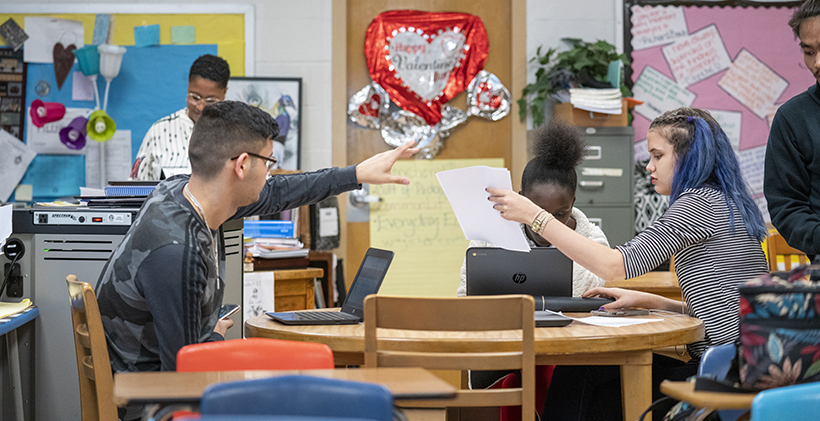This post was written by NCTE member Gary Pankiewicz.
Just as our own cultural context influences our identity and values, we can recognize some of the cultural contexts that influence our students’ racial and ethnic identities and values, as well as the challenges they face. But how can we make an investigation of these cultural contexts more consistent in our approaches to literature in the classroom? It makes sense to provide more access to diverse texts, but, culturally responsive pedagogy suggests that exploring instructional practices to enhance cultural perspective is just as important. One practical idea in the ELA classroom is to make room for an exploration of culture in our narrative reading strategies.
In my experience, many ELA teachers often use the Somebody-Wanted-But-So summarizing strategy or the “story mountain” plot-diagram visualization strategy to support their students’ understanding of reading and writing narrative texts. (The plot diagram is also available in PDF form.)
A quick addendum to either of these two popular strategies could be far-reaching to build cultural competence.
The S-W-B-S strategy (MacOn, Bewell & Vogt, 1991; Beers, 2003) is a prevalent approach to summarizing a text. In short, students can more readily summarize a story once they identify the following: main character (Somebody); character goals (Wants); story conflict (But), and story resolution (So then . . . ).
I suggest that a more modern conception of this strategy includes a look at cultural context in every step: Somebody in a cultural context; Wanted in a cultural context; But (include if culture plays a role in the conflict); So (include any new understandings about culture). In other words, a deliberate mini-cultural analysis could be included as students trace the action of a text.
Let’s take Meg Medina’s Merci Suarez Changes Gears, a 2019 Newbery Medal-winning middle grade novel, for example. Merci Suarez is the “Somebody,” and her cultural context is significant. She is a Cuban American girl who comes from a working-class family invested in Cuban traditions in southern Florida. Her house sits amid a row of three houses referred to in the story as “Las Casitas” (translated to mean “little houses”), where her aunt and grandparents live in the other two houses nearby. Merci “Wanted” to maintain good grades so that she could keep her scholarship and make the soccer team in a private school, where there are not many other Latina students. “But” issues involved with Merci’s cultural identity are relevant to her confrontation with a school bully and a family health concern. When cultural context is examined in each step, we are left with a “So” that enhances our cultural perspectives, such as Merci’s reverence for her family and extended family that is threaded throughout the text.
The same concept could be used when identifying the elements of plot or a story mountain. In each step (i.e., exposition, narrative hook, exposition, and resolution), ask students, “What role, if any, does culture play in this part of the story?”
This could evolve into a story mountain graphic organizer that makes room for additional annotations on culture (e.g., how Merci’s grandparents say they are sorry through good Cuban food and a game of dominoes). This approach could foster a denouement that surpasses a coming-of age-story of a new middle schooler and, instead, also explores some of the cultural complexities, assets, and constraints of a young Cuban-American girl in a particular setting and context.
Culturally responsive texts or texts selected with our students’ diverse interests and learning needs in mind lend themselves to these approaches more than others. In any case, additional culturally responsive texts and this quick supplement to these common narrative reading strategies can contribute to building our students’ cultural competence over time.
Find more about the S-W-B-S strategy:
The Reading Strategies Book, by Jennifer Serravallo. (Heinemann, 2015.)
When Kids Can’t Read, What Teachers Can Do: A Guide for Teachers, 6–12, by Kylene Beers. (Heinemann, 2003.)
Responses to Literature, by Diane Bewell, James M. Macon, and MaryEllen Vogt. (International Reading Association, 1991.)
 Gary Pankiewicz is a teacher-writer and administrator with research interests in supporting reflective practice, multimodal literacies, and voice-filled curriculum and instruction. He works as a K–12 ELA supervisor in Fair Lawn Public Schools, New Jersey, and as an adjunct reading professor and writing instructor at Montclair State University. Twitter: @gpankiewicz
Gary Pankiewicz is a teacher-writer and administrator with research interests in supporting reflective practice, multimodal literacies, and voice-filled curriculum and instruction. He works as a K–12 ELA supervisor in Fair Lawn Public Schools, New Jersey, and as an adjunct reading professor and writing instructor at Montclair State University. Twitter: @gpankiewicz
It is the policy of NCTE in all publications, including the Literacy & NCTE blog, to provide a forum for the open discussion of ideas concerning the content and the teaching of English and the language arts. Publicity accorded to any particular point of view does not imply endorsement by the Executive Committee, the Board of Directors, the staff, or the membership at large, except in announcements of policy, where such endorsement is clearly specified.

